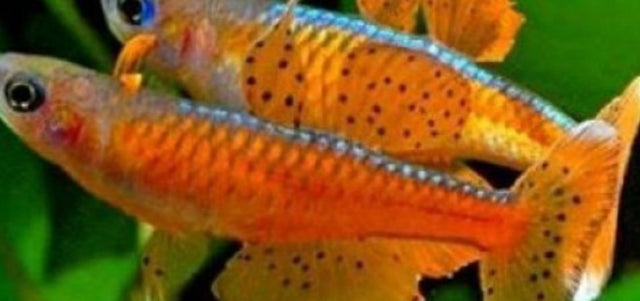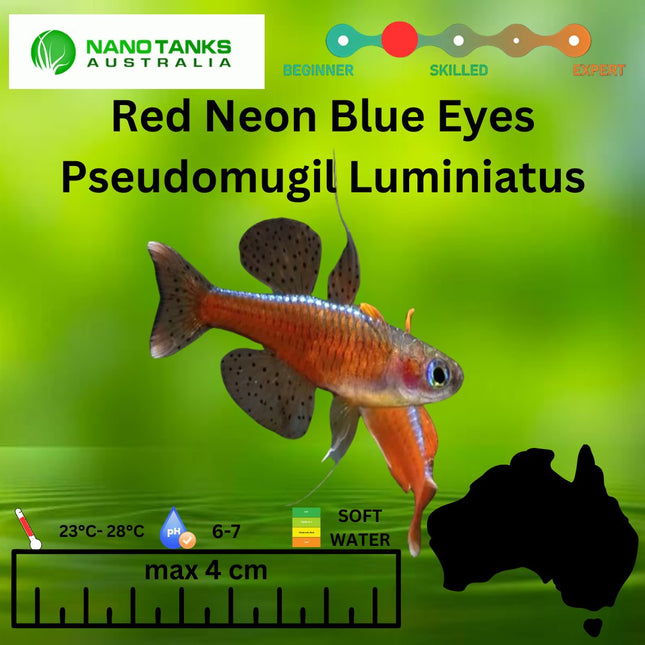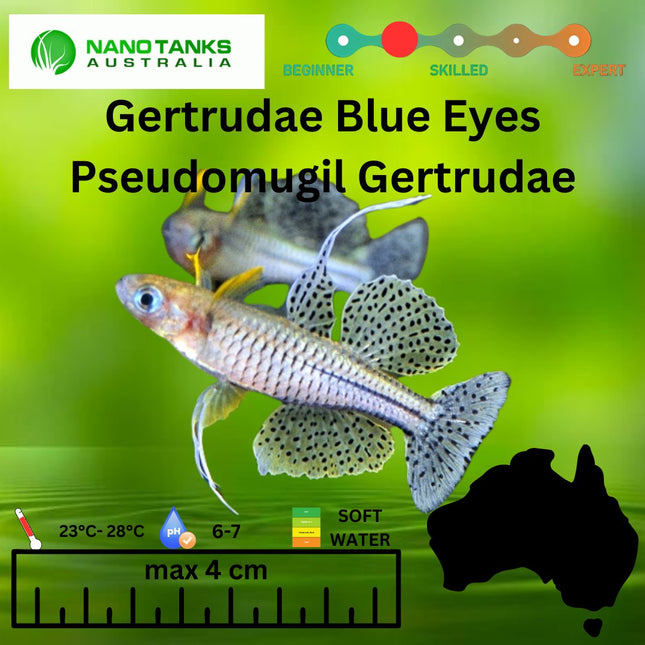Check out our range of stock.
Didn't find what you like?
Send us a message
Found something out of stock?
Send us a message

Australia and New Guinea has some very nice native fish.
One group of Native Fish are the Blue Eyes (Pseudomugil)
In this group we have the following species
Pseudomugil connieae
Pseudomugil cyanodorsalis
Pseudomugil furcatus
Pseudomugil gertrudae
Pseudomugil inconspicuus
Pseudomugil ivantsoffi
Pseudomugil luminatus
Pseudomugil majusculus
Pseudomugil mellis
Pseudomugil novaeguineae
Pseudomugil paludicola
Pseudomugil paskai
Pseudomugil pellucidus
Pseudomugil reticulatus
Pseudomugil signifer
Pseudomugil tenellus

Distribution Unconfirmed but possibly collected in the vicinity of Timika, the capital of Mimika Regency, Papua province, Indonesia.HabitatCollected exclusively from submerged riparian vegetation of terrestrial origin, and at the Samba River habitat the water was murky brown with a pH around 6.0.Maximum Standard Length30 – 35 mm.Aquarium SizeAn aquarium with base dimensions of 45 ∗ 30 cm should be the smallest considered.Water ConditionsTemperature: 18 – 26 °CpH: 6.5 – 7.5Hardness: 36 – 215 ppmSource: https://www.seriouslyfish.com/species/pseudomugil-sp-red-neon/
$39.00

Weber, 1911 Spotted Blue-eye Species Summary Pseudomugil gertrudae is a small freshwater fish growing to a size of around 30 mm and is endemic to Australia and New Guinea. They have a moderately compressed and elongated body that is a semi-transparent silvery-blue colour, sometimes having an overall wash of golden-yellow, with the swim bladder clearly visible. They have two dorsal fins, very close together, the first much smaller than the second. The tips of the pectoral fins can be bright yellow, orange or orange-red, other fins often edged with white. The dorsal, anal and tail fins can be clear to white, silvery-grey or yellow with rounded or oblong dark spots scattered all over. Several rows of body scales are edged in black forming an attractive latticework pattern over the body. All scales except those of the mid-dorsal and mid-ventral rows have a spot varying in size and intensity from specimen to specimen and from time to time in the same specimen, forming about 6 rows of discontinuous lines, except for the mid-lateral stripe, which tends to be continuous from just below and in line with the origin of the first dorsal fin to the caudal peduncle. Females generally have a deeper body than the males whilst the adult males have larger dorsal, anal and pelvic fins, with extended filaments on the first dorsal and pelvic fins. Males also exhibit more intense spotting on the body and fins. This species has a patchy distribution where it occurs and as such, there is considerably variation between the different populations in colouration and body size, as well as fin size and shape. The variety from Weipa is one of the most impressive forms and can be found in Melaleuca swamps besides the road leading into town. A similar form can be found in Pappan Creek that flows into the Mission River. The forms typical of those found at the top of Cape York in areas such as the Jardine River (and its associated swamps) and Burster Creek have large round fins and multiple small spots. In Arnhem Land a nice form with golden body colours occurs in Goanna Lagoon while not far away in the Giddy River the fish have larger fins with larger spots but no golden body colour. Specimens collected in the Darwin region typically have orange pectoral fins. There are many other forms of this beautiful little fish and new ones are regularly being discovered. Pseudomugil gertrudae from the Aru Islands are larger and have an overall golden colour (fins and body). To date there has been no research published on the genetic or physical characteristics of the various populations. Pseudomugil gertrudae is very similar to the endemic New Guinea species, Pseudomugil paskai. Both species are characterised by rows of permanent spots covering the fins. The only differences being the colour and shape of the fins. Pseudomugil gertrudae were originally collected from Terangan Island (one of the Aru Islands), which lies directly south of the Vogelkop Peninsula in western New Guinea. They were described by Max Wilhelm Carl Weber, Professor of Zoology at the University of Amsterdam in 1911 and named "gertrudae" after the wife of Dr. Hugo Merton, a German naturalist who travelled through the Aru Islands between October 1907 and August 1908. Distribution Map (Absence from other catchments may reflect a lack of sampling rather than non-existence.) Distribution & Habitat In Australia, Pseudomugil gertrudae has been found in scattered localities in river systems which flow into the Timor Sea and Gulf of Carpentaria - from Darwin through Kakadu and Arnhem Land to Cape York Peninsula, including the offshore islands of Bathurst, Melville and Groote Eylandt, plus some of the islands in the Torres Strait. They are widespread throughout Cape York Peninsula, extending down the eastern coastal plains to around the Innisfail - Tully region. Their known distribution within Australia includes the Adelaide, Alligator, Blyth, Buckingham, Cadell, Cato, Daly, Finniss, Liverpool, and the Moyle River systems in the Northern Territory; including the smaller catchments around Darwin. In Queensland they have been found in the Barron, Coen, Dulhunty, Embley, Endeavour, Jacky Jacky, Jardine, Johnstone, McIvor, Moresby, Mulgrave, Murray, Olive, Russell, Tully and Wenlock Rivers, plus the smaller coastal streams. They have also been found in oligotrophic sand dune lakes in the Cape Flattery and Shelburne Bay region. The known New Guinean distribution includes the Aru Islands, the Pahoturi, Fly (Elevala River, Lake Bosset) and Bensbach (Torassi) river systems. They probably occur elsewhere along the southern coast of New Guinea that has suitable habitat. Pseudomugil gertrudae are found in small creeks, lagoons, billabongs, swampy marshes and rainforest streams, often associated with dense aquatic vegetation, woody debris and leaf litter. They are almost exclusively found in vegetated lagoons and backwaters with clear water where they can be seen swimming in the shallow waters along the margins. Floating species of waterplants or bottom rooted emergents with floating leaves occur in most, if not all, of their natural habitats. Substrates are usually mud or silt, and there is an abundance of water plants growing to the surface around the margins. Sometimes they may have water plants growing in the deeper water in the middle. Lagoons often have a thick layer of leaf litter around the margins. They are seldom found in turbid lagoons, even when there are abundant water plants. The water in some habitats is often intensely discoloured by tannic acids leached from decaying vegetation. These 'blackwater' habitats are generally acidic, with pH levels from 3.9 to 6.8, have low conductivity (dissolved ions), and vary in their dissolved organic matter, ionic composition, and colour. Alkalinity and hardness levels are very low. Factors contributing to these variations are age, formation, layers of low permeability and peats, proximity to the sea, surrounding vegetation, and the extent to which leaf litter accumulates and decays in the water. However, habitat conditions can vary substantially and Pseudomugil gertrudae have been collected from natural habitats within the following range of water conditions: Temperature: 12-34° Celsius pH 3.68-9.4 Conductivity: 12-646 µS/cm Hardness 0-320 ppm Alkalinity 2-180 ppm
$29.00 $19.00